My wife’s rifle recently got an upgrade in the form of a Velocity 10/22 Trigger Kit With Mag Release from Velocity Precision Engineering. Tom Vehr, with more than three decades of experience in trigger design, manufacture, and assembly, owns Velocity. His decades of experience suggest he knows a thing or two about good trigger design.
While Velocity offers several options for the AR platform, it was their 10/22 trigger that initially caught my attention. Then I noticed that they are offered in several colors, including purple. Promises of better performance were my primary interest, but I hadn’t found a good purple trigger for my wife’s rifle. So I reached out for one of his flat-faced 10/22 trigger kits with a matching extended magazine release.
The Velocity 10/22 Trigger Kit With Mag Release
This kit includes a new trigger, hammer, sear, disconnect, and two plunger springs. Although curved triggers are available, I chose the flat one. While the magazine release and trigger shoe are aluminum, the rest of the parts are tool steel. Velocity mentions that both DLC coatings by Armor Lube and NP3 coatings are used. This is done to achieve a low coefficient of friction while improving microhardness. That’s the sort of durability and wear resistance that results in a trigger that should last a lifetime. A lifetime of fun shooting, based on my experience so far.
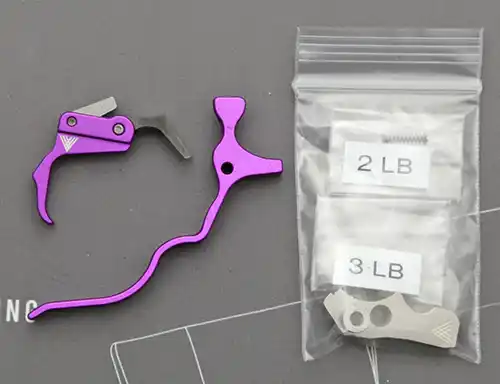
Velocity promises an easy install for their Velocity 10/22 Trigger, a smooth feel, and a clean crisp break with two and three pound options. Their claim of “Enhanced trigger finger position” seems valid, at least for me. In the smallish OEM trigger guard, their trigger fits my finger perfectly. Even though this is my wife’s rifle, it’s good to know big fingers can find a nice and consistent position.
Installation
If you’ve installed a 10/22 trigger, or even just taken one apart, this will be familiar. Push all the pins out, and let the old parts fall out. But don’t lose any. You’ll need to reuse the trigger plunger, hammer strut, ejector, magazine plunger and spring, and bolt lock spring. If you haven’t replaced the bolt release with an upgraded one, this would be a good time to do that. While I have it apart, I like to make sure all the parts are clean, and I’ll hit all friction surfaces with some Flitz polish.
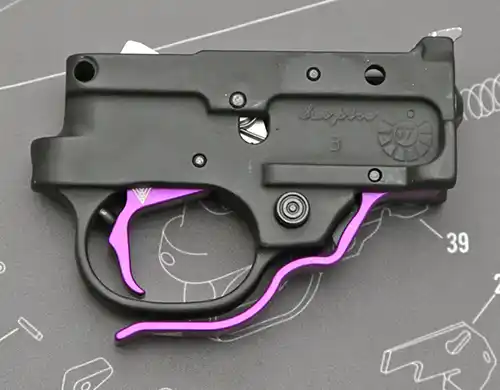
It would take me several hundred words to explain the actual installation, so I suggest checking YouTube for guidance. But it all goes back together just like an OEM trigger. Velocity even includes a slave pin, which really makes it as easy as promised. I usually replace things in the following order: trigger plunger and spring, trigger, hammer, magazine plunger/spring, bolt release, ejector, and then the hammer strut. After a quick function check, back in the rifle it goes.
Trigger feel: digital gauge vs. finger gauge
My digital trigger pull gauge is both reliable and questionable at the same time. It seems as though it reads lower than it should sometimes. So I’ll take the weight numbers with a grain of salt if they don’t agree with my highly calibrated trigger finger. But I do get consistent results with it. Where Velocity included two and three pound springs, I chose the two pound option. And the Velocity 10/22 Trigger broke consistently at just under 2 pounds every time. Over ten pulls, it averaged one pound, 14 ounces. Not sure if my obsessive polishing helped, but there’s less of that gritty feeling OEM triggers have.
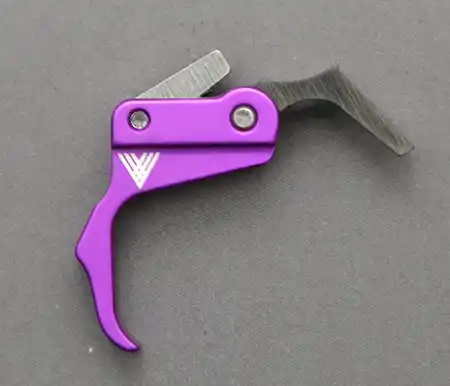
Lacking any adjustments, you have to take what you get with the Velocity 10/22 Trigger. Thankfully, what you get is really good. Mine has none of that sloppy loose feeling in the pre-travel that some triggers have. It almost feels like my two-stage trigger, where there is a bit of take-up during the initial travel. And then it does indeed have a clean and crisp break. This is where things got a little tricky for me. Using a two-stage trigger set to about a pound has ruined me for other triggers. When compared to the other two big names in drop-in trigger kits though, the Velocity easily holds its own. More on that below.
Range time
First, let me point out that my wife’s rifle is clearly meant for speed, not precision. And if you want to shoot fast, the Velocity trigger will keep up. Reset feels pretty short, and I don’t feel limited when trying to engage multiple targets. But I still shot prone as well, to see how it does with slow and deliberate shots.
The UTG green dot prioritizes speed (and budget) over precision. It’s what was available when I built this rifle during the worst of Covid. Even though I have better optics now, she hasn’t requested an upgrade. Anyway, I picked off plenty of unbroken clay pigeons with it, and I wouldn’t hesitate to use this trigger on a scoped rifle. Of course, the extended magazine release works just fine too, with nothing more than a flick of the middle finger to drop a magazine.
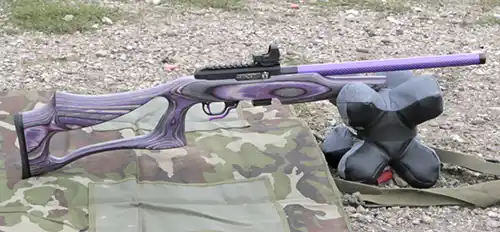
Conclusion
At $149, the Ruger 10/22 Trigger Kit With Mag Release from Velocity Precision Engineering is competitively priced. Without the magazine release, the Velocity 10/22 Trigger kit sells for $124.95, pricing it just below the competition. And that’s where things get interesting. Based on my experience, the Velocity is close enough to a certain other brand’s “trigger job” that most shooters would be hard-pressed to feel much difference.
But Velocity offers straight or curved triggers. They are available in black, blue, red, OD green, FDE, Velocity green, pink, purple, nickel, and Wolf Grey. As someone who takes new shooters to the range on a regular basis, I try to avoid the “black gun” tactical look. And I’m not alone. So a high-performance trigger in colors to match some of my more fun builds makes this an easy choice.
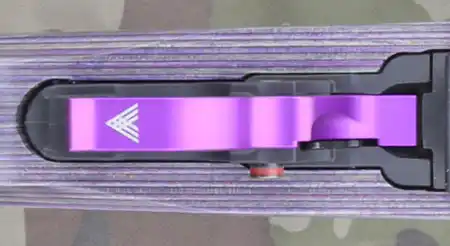
From a performance-to-value standpoint, Velocity really nailed it. To get a better trigger, you’re probably looking at a proper competition trigger, which starts at $285. Overkill (and over budget) for many shooters. For $124.95, this is a huge upgrade over the factory trigger. The two pound spring is light enough for competition use, and the three pound spring would be great for more casual use, such as hunting or plinking. All those color options should appeal to Steel Challenge builders too. After trying this one, I’m eyeing one of their complete drop-in triggers for the AR platform too.
You can find my more comprehensive article on 10/22 trigger options here
As always, I’d like to thank Velocity Precision Engineering for providing their Ruger 10/22 Trigger Kit With Mag Release for my testing and evaluation. If you’ve got a 10/22 in need of a trigger upgrade, definitely give them a look. You’ll find them at Velocitytriggers.com.
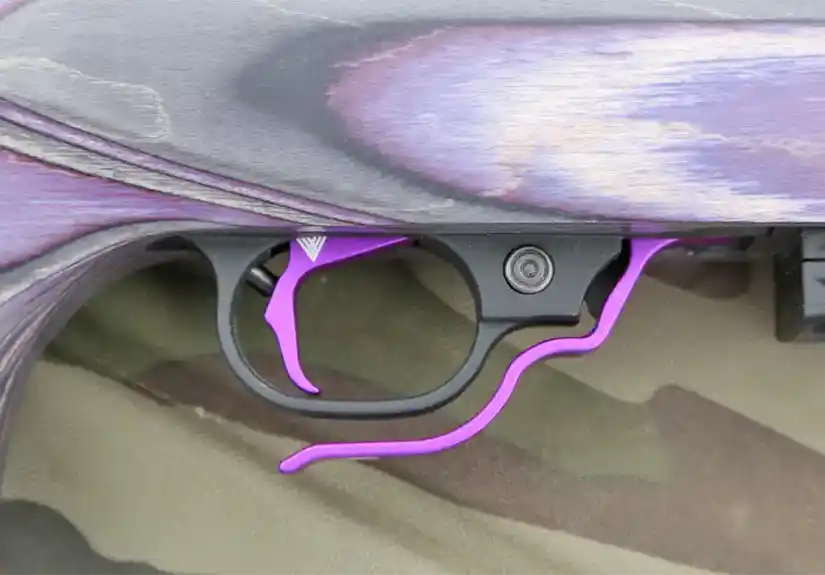
I installed one in March with the 3 lb spring. Install was uneventful, function checks went fine, and I ran ~100 rounds through it at the local range the day after without incident.
Fast forward to an Appleseed event in April where I shot about 500 rounds, and I got about a dozen malfunctions which seemed like the trigger wasn’t resetting. The first shot would go bang, and then I wasn’t able to send a second shot even though the bolt was in battery, with a fresh round in the chamber (the trigger felt “dead”) – simply cycling the bolt would get me back in business. Then towards the end of the day, I also had about 6 doubles where a single trigger pull would fire 2 shots. I pulled the trigger assembly for inspection, completely cleaned and lightly oiled the rifle but still had these intermittent issues on the second day.
I like the trigger, but it feels more like a single stage without the “clean, crisp break” advertised. Other than the trigger, the rifle is a completely stock model 31217 and has less than 1,000 rounds through it.
I sent 4 emails politely asking for help and/or advice since April and have never gotten a reply. Maybe it’s a fluke, maybe I did something wrong, but either way, the customer service after the fact is non-existent.
That’s a bit disappointing. We have two, and no issues at all. Did you install yours in a polymer housing, or the older aluminum one?